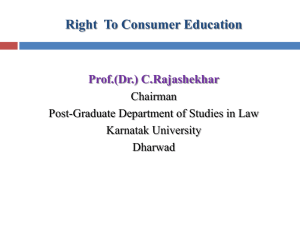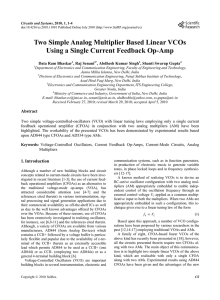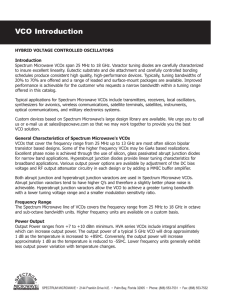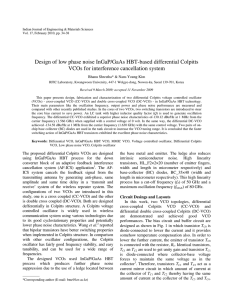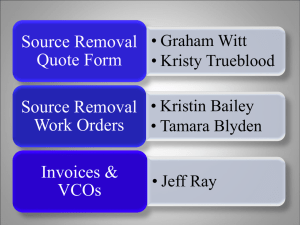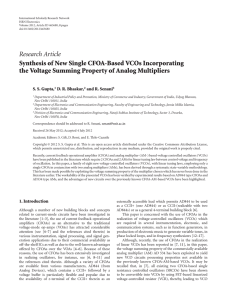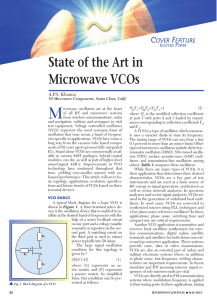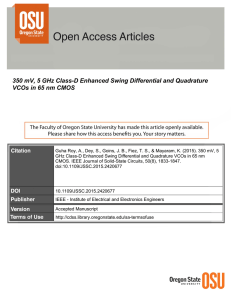Realization and implementation of current conveyor based linear
advertisement
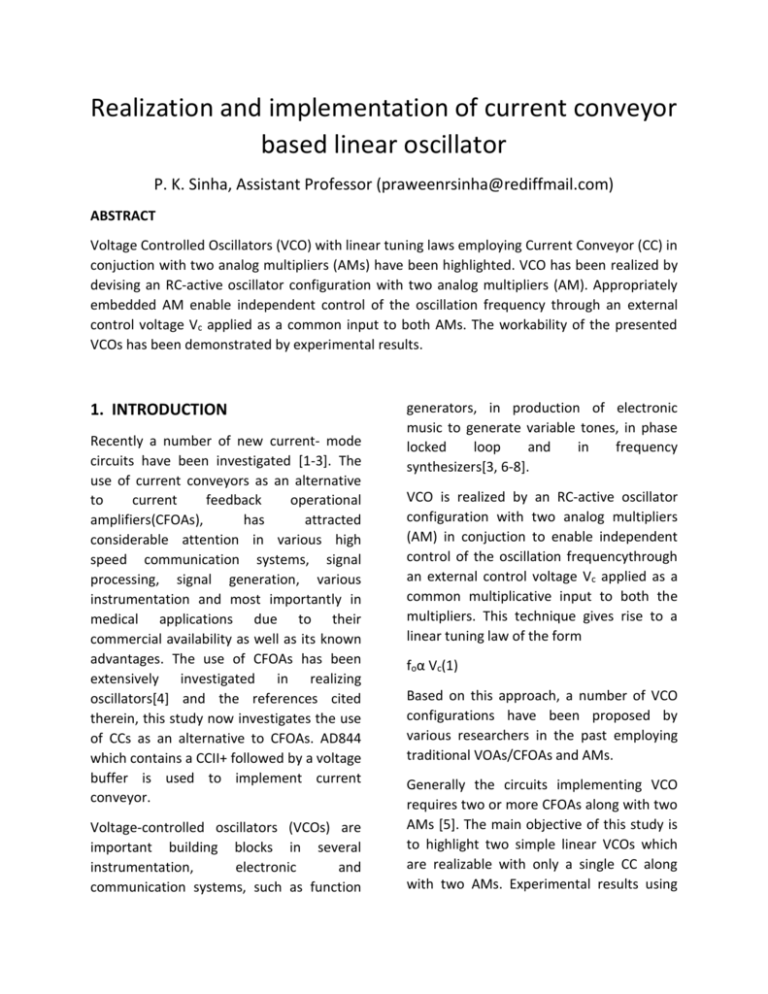
Realization and implementation of current conveyor based linear oscillator P. K. Sinha, Assistant Professor (praweenrsinha@rediffmail.com) ABSTRACT Voltage Controlled Oscillators (VCO) with linear tuning laws employing Current Conveyor (CC) in conjuction with two analog multipliers (AMs) have been highlighted. VCO has been realized by devising an RC-active oscillator configuration with two analog multipliers (AM). Appropriately embedded AM enable independent control of the oscillation frequency through an external control voltage Vc applied as a common input to both AMs. The workability of the presented VCOs has been demonstrated by experimental results. 1. INTRODUCTION Recently a number of new current- mode circuits have been investigated [1-3]. The use of current conveyors as an alternative to current feedback operational amplifiers(CFOAs), has attracted considerable attention in various high speed communication systems, signal processing, signal generation, various instrumentation and most importantly in medical applications due to their commercial availability as well as its known advantages. The use of CFOAs has been extensively investigated in realizing oscillators[4] and the references cited therein, this study now investigates the use of CCs as an alternative to CFOAs. AD844 which contains a CCII+ followed by a voltage buffer is used to implement current conveyor. Voltage-controlled oscillators (VCOs) are important building blocks in several instrumentation, electronic and communication systems, such as function generators, in production of electronic music to generate variable tones, in phase locked loop and in frequency synthesizers[3, 6-8]. VCO is realized by an RC-active oscillator configuration with two analog multipliers (AM) in conjuction to enable independent control of the oscillation frequencythrough an external control voltage Vc applied as a common multiplicative input to both the multipliers. This technique gives rise to a linear tuning law of the form foα Vc(1) Based on this approach, a number of VCO configurations have been proposed by various researchers in the past employing traditional VOAs/CFOAs and AMs. Generally the circuits implementing VCO requires two or more CFOAs along with two AMs [5]. The main objective of this study is to highlight two simple linear VCOs which are realizable with only a single CC along with two AMs. Experimental results using AD844 have been given and the advantages offered have been highlighted. 2. VCO Configurations Based on CCI A CCI is characterized by the terminal equations Ix=Iy, Vx=Vy and Iz=Ix, On the other hand, the output of an AM with two inputs V1 and V2 is of the form Vo = K , whereVref is the reference voltage of the multiplier set internally (usually 15 volts in case of AD734) and K can be set up to +1 or -1 by grounding the appropriate terminals of AD734. The proposed circuits are shown in Figure 1(a) and figure 1(b): The frequency of oscillation (FO) thus given by: FO :fo= (3) Thus, it is seen that fois linearly controllable by the external control voltage Vc , as desired. AD844 is CCII+ followed by a voltage buffer. It is converted to CCI by the circuit arrangement shown in figure 2. Because of low impedance at the input terminalCCI circuit can be used as an accurate currentamplifier. Moreover, in CCII arrangement y-terminal is grounded and this grounding must be done carefully sincea poorly grounded input terminal may cause unwantednegative impedance at the other input terminal. Figure 1(a): Proposed circuit 1 Figure 2: CCII to CCI conversion 3. Experimental Results Figure 1(b): Proposed circuit 2 Choosing the same Vref for both the multipliers in the circuits gives the condition of oscillation (CO): CO: R1 = R2 = R (say) (2) Both the VCOs have been experimentally studied using AD844 type CCI and AD734 type AMs biased with 15V DC power supplies and it has been possible to generate oscillation frequencies from few kHz to several hundreds of kHz. Experimental results of the proposed VCOs are shown in figures 3 and 4. The component values chosen are as under: For circuit of figure 1(a), R= 1kΩ, C1 = 0.1uF, C2 = 0.1uF ; For circuit of figure 1(b), R = 1kΩ, C1 = 0.1nF, C2 = 0.1nF. Figure 3(a) and figure 4(a) shows the variation of oscillation frequency with control voltage for figure 1(a) and 1(b) respectively. The practical results show a reasonably good correspondence between the theoretical and experimental results to confirm the linear tuning of the two VCOs. Figure 4. Experimental results for circuit 2 (a) Variation of frequency with Vc (b) A typical waveform generated( f= 516 kHz at Vc= 4V, V(peak to peak)= 30 mV) 4. Concluding Remarks In this study, we have highlighted two simple CCI-AM-based VCOs, providing linear tuning laws which are derived from previously known works. The workability of new VCOs has been verified and proved by experimental results. Figure 3. Experimental results for circuit 1 (a) Variation of frequency with Vc (b) A typical waveform generated( f= 127 kHz at Vc= 4V, V(peak to peak)= 250 mV) The VCOs presented here offer better gain bandwidth products than the comparable op-amps under both small and large signal conditions. It also overcomes the limitations of CFOAs in component matching.Moreover, this current-mode approach is not just restricted to current processing, but also offers certain important advantages when interfaced to voltage-mode circuits. 5. References [1] “Linear VCO with Sine Wave Output,” IEEE Transactions on Instrumentation and Measurement, Vol. 35, No.2, by S. K. Saha, 1986. Feedback Op-Amp,” by D. R. Bhaskar, R. Senani, A. K. Singh and S. S. Gupta, 2010. [2] “Linear Voltage Controlled oscillator,” IEEE Transactions on Instrumentation and Measurement, Vol. 37, No.1, by S. K. Saha and L. C. Jain, 1988. [6] “On the realization of Linear Sinusoidal VCOs,” by D. R. Bhaskar, R. Senani and M. P. Tripathi, International Journal of Electronics, 1993. [3] “Linear Sinusoidal VCO,” International Journal of Electronics, Vol. 65, No. 2,by V. P. Singh and S. K. Saha, 1988. [7] “New active-R Sinusoidal VCOs with Linear Tuning Laws,” by D. R. Bhaskar and R. Senani, 1996. [4] “Linear Sinusoidal VCOs: New Configurations Using Current Feedback OpAmps,” International Journal of Electronics, Vol. 97, No. 3, by D. R. Bhaskar, R. Senani and A. K. Singh, 2010. [8] “Realization of Novel Linear Sinusoidal VCOs,” by D. R. Bhaskar and M.P. Tripathi, Analog Integrated Circuits and Signal Processing, Vol. 24, 2000. [5] “Two Simple Analog Multiplier Based Linear VCOs Using A Single Current
